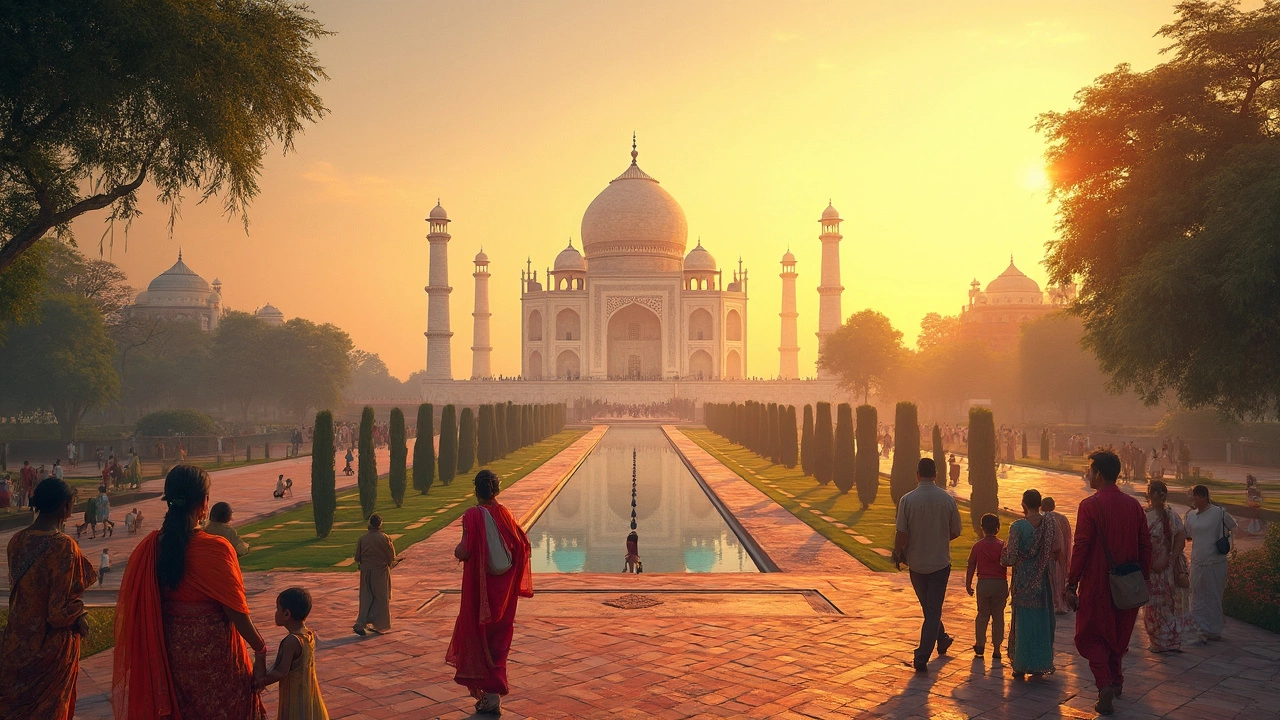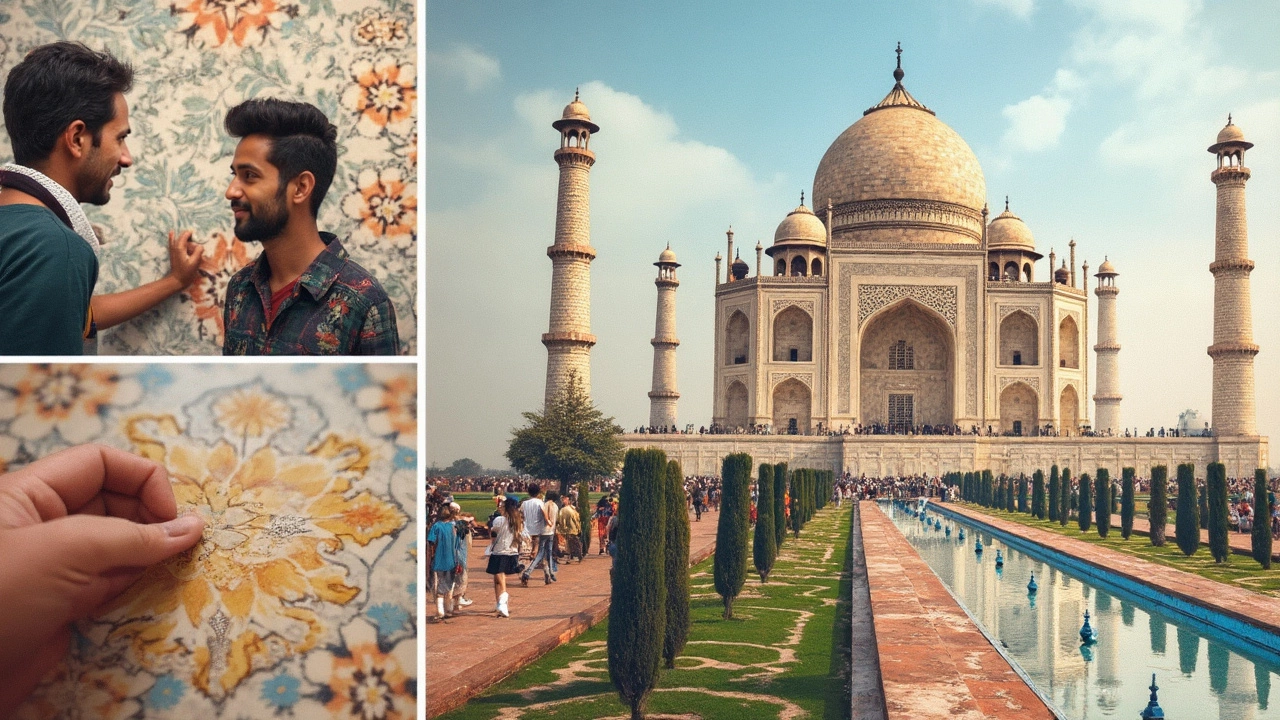Most Visited UNESCO Heritage Site in India: What You Need to Know
 May, 29 2025
May, 29 2025
The Taj Mahal isn’t just a pretty picture on postcards—it’s hands-down the most visited UNESCO heritage site in India. Over 7 million people show up every year, smartphones in hand, all for that legendary white marble view. Even if you’re not a history nerd, standing in front of it hits different. You can see why the crowds keep coming back: It’s equal parts romance, human story, and pure marble magic.
If you’re thinking of joining those millions, don’t just show up at noon with no plan. You can actually skip the longest lines by booking your tickets online ahead of time; the official Archaeological Survey of India website works if you want to avoid ticket scammers. Early morning visits are your best bet for quiet moments and cooler weather, plus you’ll dodge the endless tour buses.
- Why the Taj Mahal Tops the Charts
- Planning Your Visit: What to Expect
- Surprising Facts About the Taj Mahal
- How the Taj Stands Out Among Indian UNESCO Sites
Why the Taj Mahal Tops the Charts
If you ask anyone what’s the first thing that pops up when they think of Taj Mahal, it’s always that perfect photo of the white marble dome reflected in the long pool. But the real draw goes way beyond just a good selfie. The Taj isn’t only India’s most famous landmark, it pulls the most visitors of all UNESCO sites in the country—and it’s easy to see why.
The place is a magnet not just for Indians, but for travelers worldwide. In a regular year, about 7 to 8 million folks walk through its gates. Out of these, nearly a million come from outside India. That’s a pretty wild number for any monument, especially considering UNESCO has listed over 40 heritage sites in India alone.
| Year | Total Visitors | Foreign Visitors |
|---|---|---|
| 2018 | 7.8 million | 972,726 |
| 2019 | 7.6 million | 938,201 |
| 2022 | 6.5 million | 320,000 |
So, what makes it so special? Here’s the deal:
- Global Icon Status: Most people can recognize the Taj on sight—no explanations needed.
- Unbeatable Love Story: Mughal emperor Shah Jahan built it for his wife Mumtaz Mahal, which sounds straight out of a movie script.
- Jaw-dropping Architecture: Its symmetry and the detail in the marble inlay work are unreal. No wonder it’s called one of the New Seven Wonders of the World.
- Easy Access: Located in Agra, just a short ride from Delhi, you can see it in a day trip, which adds to its popularity.
No other Indian heritage site comes close, whether we’re talking visitor numbers or world fame. Most tourists admit if you're doing a first trip to India, it’s at the very top of the must-see list. The Taj simply checks every box: history, beauty, and that feeling you get when you finally see it in real life.
Planning Your Visit: What to Expect
If you want your Taj Mahal experience to be smooth, a bit of prep goes a long way. First up, don’t bother showing up on a Friday—the Taj is closed for regular visitors then, since it’s only open for mosque prayers. Doors open at sunrise and close at sunset the rest of the week, which means you’ve got a decent window, but early mornings are gold if you hate crowds and the afternoon heat.
You can grab your tickets online at the official ASI website or at ticket counters near the entrances. Online tickets come with a QR code, so just show your phone and walk in—no need to print. Indian citizens and foreign tourists have different rates, and there's an extra fee for getting close to the main mausoleum. Here’s a quick breakdown:
| Category | Basic Entry | Mausoleum Access |
|---|---|---|
| Indian Citizens | ₹50 | +₹200 |
| Foreign Tourists | ₹1100 | +₹200 |
Bags are checked, and there’s a whole list of stuff you can’t bring inside—honestly, skip the tripods, food, or big bags unless you want extra hassle. Water’s fine if it’s bottled, and cell phones are allowed, but large electronic gadgets aren’t. You won’t find a ton of shade, so pack sunscreen and don’t forget your sunglasses.
There are actually three gates: East, West, and South. Most people use the East or West gate since the South is for exit only. The Taj Mahal sits right by the Yamuna River, so the best photos are usually early morning when the light is soft and you catch the reflection in the water. No tripods, though—they’re not allowed unless you’ve got a special permit.
- Arrive before 8am during peak tourist season (October to March).
- Taxis and buses can drop you off only so close—no vehicles are allowed in the immediate 500m zone to control pollution. There are golf carts and rickshaws from the drop-off point.
- Restrooms are outside the main complex, so plan ahead before you enter.
If you want those classic photos without a ton of strangers in the background, aim for a weekday and steer clear of big holidays like Diwali or Eid, when local crowds spike. With a little planning, your day at India’s most epic landmark can be pretty unforgettable, and a whole lot less stressful.

Surprising Facts About the Taj Mahal
Think you already know everything about the Taj Mahal? You’ll probably still find a couple of things here that surprise you. The Taj wasn’t just built as a monument—it was a love story carved in marble. Mughal emperor Shah Jahan had it made as a tomb for his favorite wife, Mumtaz Mahal, back in the 17th century. The building took about 22 years and over 20,000 workers to finish. There was no fancy machinery back then—just pure human effort and some serious teamwork.
Here’s something wild: the Taj Mahal actually changes color depending on the time of day and even the weather. It picks up a soft pink glow in the morning, a bright white shine at noon, and a golden tint under the moonlight. Locals like to joke that it’s got a mood to match every sky.
Don’t worry about the rumors you might have heard about Shah Jahan chopping off his workers’ hands. There’s no solid proof for that. Most historians say it’s just a myth that started way after his time.
Another cool thing—the main building uses pure white marble brought all the way from Makrana in Rajasthan. Some of the decorations even include rare gemstones like jade and turquoise, carved right into the walls in detailed floral patterns. And here’s a spot most tourists miss: each of the four minarets actually leans a bit outwards. Why? In case of an earthquake, they’d fall away from the main structure instead of crashing into it.
- Every year, the Taj gets a ‘facial’ using a clay called Multani Mitti to keep the marble looking fresh and clean.
- Unlike most tombs, the cenotaph you see inside isn’t the real grave—Mumtaz and Shah Jahan are buried in a quiet crypt below, closed to the public.
- The Taj Mahal is perfectly symmetrical except for the tomb of Shah Jahan, which was added later and breaks that symmetry.
If you want the real magic, head there under a full moon, when the Taj opens for special nighttime viewing. The effect is next-level—the whole place looks like it’s glowing. That’s a must-see for anyone who wants a different take on this world-famous spot.
How the Taj Stands Out Among Indian UNESCO Sites
There’s no shortage of UNESCO heritage spots in India—over 40, actually. Think of forts like Agra and Amber, natural wonders like Kaziranga National Park, and ancient caves like Ajanta and Ellora. But here’s the thing: nothing pulls crowds quite like the Taj Mahal. That moon-white dome simply outshines every other contender on the list, numbers-wise and in the way it sticks in your memory.
People sometimes ask, why does the Taj get all the attention when places like Qutub Minar or Hampi are also unique? There are a few reasons:
- Universal Symbol: Ask anyone what they picture when they think of India, and nine times out of ten it’s the Taj Mahal. It’s a symbol not just of Agra or even India, but of pure love and art.
- Accessibility: The Taj is super easy to reach compared to, say, the caves in Maharashtra or the remote national parks. Trains, flights, taxis—you name it, you can get there without a headache.
- Popular All Year Round: The crowds don’t really drop off. Some places are seasonal, like the hill forts or wildlife sites, but the Taj pulls steady numbers every single month.
- Global Media Buzz: From fashion shoots to Bollywood hits, it shows up everywhere. You see it in wedding photos, travel blogs, even music videos. That helps keep it front and center in everyone’s mind.
Let’s put the stats next to each other for perspective:
| UNESCO Site | Annual Visitors (approx.) | Location |
|---|---|---|
| Taj Mahal | 7-8 million | Agra, Uttar Pradesh |
| Qutub Minar | 3.5 million | Delhi |
| Red Fort | 2.5 million | Delhi |
| Mysore Palace | 3 million (not UNESCO) | Mysore, Karnataka |
| Ajanta & Ellora Caves | 1.2 million combined | Maharashtra |
What’s wild is even non-UNESCO spots like Mysore Palace don’t come close. And while natural UNESCO sites like Kaziranga or Sundarbans are jaw-dropping, only the Taj has that mix of beauty, crazy story, and mass fame. Plus, security and crowd management here are way tighter—they keep pushing for a cleaner, smoother experience, even with the floods of people.
So if you’re after a spot that has both history and non-stop buzz, the Taj Mahal stands in a league of its own among India’s UNESCO heritage sites. Nothing else brings together easy travel, iconic status, and those ‘wow’ moments like it does.